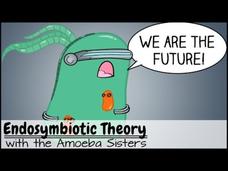SciShow
When Algae Learned to Hunt
You probably don't consider algae to be super aggressive, but 66 million years ago had to turn to murder in order to survive.
Amoeba Sisters
Bacteria (Updated)
Let the Amoeba Sisters introduce you to bacteria! This video explains bacterial structure, reproduction, and how not all bacteria are "bad!" Video also briefly mentions endospores, plasmids, and bacteria transformation. Table of...
Amoeba Sisters
Autotrophs and Heterotrophs
Curious about modes of nutrition? Join the Amoeba Sisters in learning about autotrophs and heterotrophs. Video explains these terms as well as how their carbon source differs. Photoautotrophs, photoheterotrophs, chemoautotrophs, and...
Crash Course
Taxonomy: Life's Filing System - Crash Course Biology
Hank tells us the background story and explains the importance of the science of classifying living things, also known as taxonomy.
SciShow
When Algae Learned to Hunt
You probably don't consider algae to be super aggressive, but 66 million years ago had to turn to murder in order to survive.
Curated Video
I WONDER - What Is A Trophic Level?
This video is answering the question of what is a trophic level.
Professor Dave Explains
Food Webs and Trophic Cascades
Now that we know about nutrient cycling, we are ready to look at food webs as a whole. These represent feeding relationships within a community.These relationships designate certain trophic levels, so let's learn about what these mean...
Professor Dave Explains
Energy Flow and Nutrient Cycling in Autotrophs and Heterotrophs
The biosphere is an extremely dynamic system, with energy flowing from one group of organism to another at all times. How does this flow operate? How do nutrients cycle? What is biomass? What are gross and net primary productivity? Let's...
Visual Learning Systems
Plant-Like Protists: Their Importance and Diversity
This video discusses the main difference between plant-like protists and animal-like protists. The video also highlights various examples of plant-like protists, such as euglenoids, diatoms, dinoflagellates, and different types of algae....
Curated Video
Nutrition and Energy Flow Part 1
In this section, I talk about the sun as a source of energy, consumers vs. producers and cycles found in nature
msvgo
Energy Flow in Ecosystem
It explains the unidirectional flow of energy through different trophic levels; energy flow maintained by laws of thermodynamics, food web, food chain and the ten percent law.
Ancient Lights Media
Biological Classification - The Four Kingdoms of Eukarya
Biological Classification Set: This clip introduces the four kingdoms of, Eukarya: Protista, Plantae, Animalia and Fungi.
Visual Learning Systems
Classification and Characteristics of Eubacteria and Archaebacteria
In this video, the topic of discussion is the classification of bacteria, specifically focusing on two distinct kingdoms: eubacteria and archaebacteria. The speaker mentions that scientists do not fully agree on the classification of...
Visual Learning Systems
Viruses and Monerans: Bacterial Shapes and Activities
Practical examples show how viruses and bacteria are both beneficial and harmful to humans. Animations describe the structure of a virus, and explain how they reproduce and cause disease. Microscopic images illustrate different types and...
Amoeba Sisters
Endosymbiotic Theory
Eukaryotes—were we born from an act of predation that backfired? Ponder this and other questions of evolution with a video from a well-written biology playlist. Topics include the origins of mitochondria and chloroplasts, unusual...
Teacher's Pet
Energy Transfer in Trophic Levels
Learn more about food chains, the food web, and the concepts relating to them. It focuses on consumers, producers, decomposers, energy transfer, and energy loss across trophic levels.
Teacher's Pet
Introduction to Photosynthesis
Introduce viewers to photosynthesis with a video that begins by explaining the differences between heterotrophs and autotrophs. Then it describes photosynthesis and offers the chemical equation for this process.
SciShow
3 Amazing Photosynthetic Animals
The spotted salamander is currently the only known photosynthetic vertebrate. A video introduces three animals that are all photosynthetic in their own way. It explains the way they get energy from the sun as well as other quirky traits...
Bozeman Science
Photosynthesis and Respiration
View how autotrophs and heterotrophs use the energy of the sun to form the energy their cells need, ATP. Learners watch an informative video that details the processes of photosynthesis, learning where it occurs, what...
Amoeba Sisters
Food Webs and Energy Pyramids: Bedrocks of Biodiversity
How come we don't eat worms, but we eat fish that eat worms? A video features the food chain and explains why a food web is a better explanation for biodiversity. It includes explanations of producers, autotrophs, consumers,...
Khan Academy
Khan Academy: Ecology: Flow of Energy and Matter Through Ecosystems
Seeing how energy and matter flows and is recycled from primary producers (autotrophs) to primary, secondary and tertiary consumers. [10:25]







